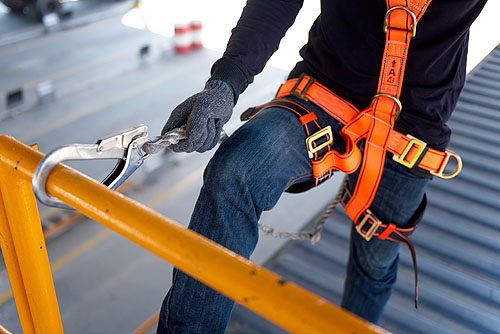Being a construction workers is one of the most dangerous jobs in the United States. According to the US Bureau of Labor, over 1,100 people died in the construction industry in 2019, accounting for over 20% of all workplace fatalities. Even worse, according to the CDC, small builders (20 or fewer employees) were responsible for 75% of all fatal construction falls between 2015 and 2017.
As a builder, it’s your job to keep your construction workers and crews of subcontractors safe. From fall prevention to proper equipment management, here are five safety precautions you should always follow.
1. Wear the proper gear
Personal protective equipment (PPE) can be the difference between life and death for construction workers. While you should always follow local laws and regulations, here are a few specific safety tips to consider regarding proper equipment.
- As a general rule, construction workers should always wear high-vis clothing when working on or near construction equipment.
- Wear OSHA-approved footwear. In general, work boots should be puncture- and slip-resistant, capable of protecting workers from falling debris and heavy equipment, and ideally, steel or composite toed.
- Use proper masks and respirators to protect against hazardous or toxic dusts.
- Use back braces when lifting heavy items, and always lift with your knees.
- Wear heavy-duty gloves and goggles whenever you’re using or near power tools.
- Require safety harnesses and whenever construction workers are working high up (including on ladders).
Finally, make sure your construction workers take care of their PPE. Encourage them to store their equipment in a safe, dry place. And be sure to examine all PPE before use to assure that it’s still in working order.
2. Use caution with heavy equipment and ladders
One of the most common ways workers get injured is getting in and out of heavy equipment or on and off ladders. While heavy machinery operation comes with some obvious risks, it’s the little things that often lead to injury or death. You can minimize this risk by encouraging your team to follow these preventative safety tips:
- Regularly check gloves and boots for mud, grease, or any other slippery substances.
- Use the Three-Point System whenever possible. This means assuring that your workers always have three points of contact (2 hands and 1 foot, or 1 hand and 2 feet) when entering, using, or exiting a piece of heavy machinery, or climbing a ladder.
- Use step ladders to make it easier to climb onto equipment.
- Ask for help when necessary without worrying about interrupting other jobs.
- Go slow and avoid jumping or hopping down from equipment.
Slips and falls are a common but often overlooked cause of workplace deaths and injuries.
3. Be careful loading and unloading
Loading and unloading is another safety hazard to consider. Materials, equipment, and other construction workers can enter loading and unloading zones suddenly. Train your workers to have their head on a swivel, always watching their surroundings.
Additionally, take these additional precautions:
- Keep ramps dry, straight, and clear.
- Assign spotters to help workers load and unload heavy or awkward items.
- Use correct tie-down procedures.
- Always double-check that you and your trailer decks have proper clearance.
4. Thin the crowd
Crowding significantly increases the risk of accidents and injuries. Discourage your crew from gathering to watch large machines work. Carefully schedule each task in a way that minimizes overlap between your crew and the crews of your subcontractors.
While it shouldn’t be your equipment operators’ job to make sure people are standing back, they should always ensure sure no one is standing nearby.
5. Review the most common causes of accidents
With safety, knowing is half the battle. Virtually every worker eventually suffers a muscle injury or small laceration at some point on a construction job site. However, serious injuries should be exceedingly rare if you know what to watch out for.
Take the time to review OSHA’s list of hazards and solutions in residential construction. While there are many things to consider, it’s crucial that you follow them as closely and diligently as possible. When it comes to protecting your company and the people who work for you, knowledge is the most important tool you can have.
Learn how you can protect your business and add valuable selling points to your new builds with a 2-10 HBW structural warranty.
Related content
4 Reasons Why New-Home Volume Builders Prefer 2-10 HBW








